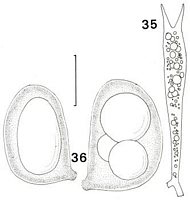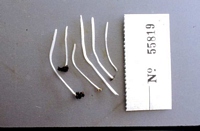|
 Clavaria ypsilonidia Clavaria ypsilonidia
BiostatusPresent in region - Indigenous. Endemic
Images (click to enlarge)
Caption: Fig 35-36. Clavaria ypsilonidia. 35,basidium (not to scale). 36, spores. TENN no. 42411.
Scale bar = 5 µm | 
Caption: Microfiche 1-28. Clavaria ypsilonidia. TENN no.43564. |
Article: Petersen, R.H. (1988). The clavarioid fungi of New Zealand. New Zealand Department of Scientific and Industrial Research, Bulletin 236: 170 pp. Wellington:.
Description: Fruit bodies up to 90 x 3 mm, simple clubs, cylindrical, scattered to gregarious, arising from
small whitish mycelial patches. Club ivory to pale greenish yellow (off-white to "pale olive-buff"), opaque, appearing waxy; equal to
tapering slightly upward; flesh concolourous. Stipe up to 40 x 2 mm, shining-silky, off-white, equal.
Tramal hyphae inflated, long-celled, thin-walled, clampless, parallel, tightly packed, free to
adherent; secondary septa common; crystalline material deposited among tramal hyphae.
Subhymenium poorly developed, pseudoparenchymatous. Hymenium hardly thickened;
basidia (Fig. 35) 30-35 µm long, clavate, narrow and attenuate below, clamped; contents
multiguttulate at maturity; sterigmata 2, long, stout, somewhat divergent, straight.<
Spores (Fig. 36) 8.6-10.8 x 6.5-7.6 µm (E = 1.19-1.67; Em = 1.40; Lm = 9.84 µm),
subglobose to broadly ellipsoid, smooth, thin-walled; contents opalescent; hilar appendix
prominent, broad, papillate.
Habitat: On leaf humus and very rotten, soggy wood.
Notes: corner (1970) included four taxa with white fruit bodies and broad spores in subg.
Holocoryne. None is 2-sterigmate, and I can find no other report of such a fungus in the
literature on Pacific taxa.
This and Clavaria subsordida were placed under a single taxonomic designation based on
fruit body morphology, for they are extremely similar macroscopically. Closer examination
revealed that C. ypsilonidia produced ellipsoid spores and strictly 2-spored basidia,
immediately separating it from C. subsordida. Also, both taxa are similar in fruit body colour
and stature to C. echino-olivacea, which produces spiny spores. Care must be taken to
distinguish these three taxa.
Basidia in Clavaria ypsilonidia are short (not more than 50 µm long by hymenial
measurements) and somewhat agglutinated, obscuring the basal loop-like clamp. The basidia
of C. subsordida are virtually free (not agglutinated) and the clamp - or bifurcate basidial
base - is easily observed.
Fruit bodies of the species vary in colour from virtually pure white (which I originally
designated a separate species) to pallid olive-buff, sometimes with the club pigmented but
not the stipe. This colour variation appears irregular, however, and unaccompanied by micro
morphological variation, so I consider that no separate taxa are warranted.
|